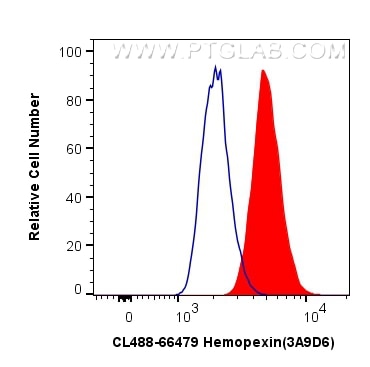Hemopexin Monoklonaler Antikörper
Hemopexin Monoklonal Antikörper für FC (Intra)
Wirt / Isotyp
Maus / IgG1
Getestete Reaktivität
human
Anwendung
FC (Intra)
Konjugation
CoraLite® Plus 488 Fluorescent Dye
CloneNo.
3A9D6
Kat-Nr. : CL488-66479
Synonyme
Geprüfte Anwendungen
| Erfolgreiche Detektion in FC (Intra) | HepG2-Zellen |
Empfohlene Verdünnung
| Anwendung | Verdünnung |
|---|---|
| Durchflusszytometrie (FC) (INTRA) | FC (INTRA) : 0.80 ug per 10^6 cells in a 100 µl suspension |
| It is recommended that this reagent should be titrated in each testing system to obtain optimal results. | |
| Sample-dependent, check data in validation data gallery | |
Produktinformation
CL488-66479 bindet in FC (Intra) Hemopexin und zeigt Reaktivität mit human
| Getestete Reaktivität | human |
| Wirt / Isotyp | Maus / IgG1 |
| Klonalität | Monoklonal |
| Typ | Antikörper |
| Immunogen | Hemopexin fusion protein Ag8533 |
| Vollständiger Name | hemopexin |
| Berechnetes Molekulargewicht | 254 aa, 29 kDa |
| Beobachtetes Molekulargewicht | 65-75 kDa |
| GenBank-Zugangsnummer | BC005395 |
| Gene symbol | Hemopexin |
| Gene ID (NCBI) | 3263 |
| Konjugation | CoraLite® Plus 488 Fluorescent Dye |
| Excitation/Emission maxima wavelengths | 493 nm / 522 nm |
| Form | Liquid |
| Reinigungsmethode | Protein-G-Reinigung |
| Lagerungspuffer | PBS with 50% glycerol, 0.05% Proclin300, 0.5% BSA |
| Lagerungsbedingungen | Bei -20°C lagern. Vor Licht schützen. Nach dem Versand ein Jahr stabil. Aliquotieren ist bei -20oC Lagerung nicht notwendig. 20ul Größen enthalten 0,1% BSA. |
Hintergrundinformationen
Hemopexin (HPX) is the plasma protein responsible for scavenging heme, thus preventing heme-mediated oxidative stress and heme-bound iron loss. In addition, hemopexin blocks heme activation of immune receptors and vascular inflammatory processes. It is mainly expressed in liver, the synthesis of which is induced after inflammation. Alterations of plasma hemopexin level have been linked to disorders like atherosclerosis and inflammatory diseases.
Protokolle
| PRODUKTSPEZIFISCHE PROTOKOLLE | |
|---|---|
| FC protocol for CL Plus 488 Hemopexin antibody CL488-66479 | Download protocol |
| STANDARD-PROTOKOLLE | |
|---|---|
| Klicken Sie hier, um unsere Standardprotokolle anzuzeigen |


